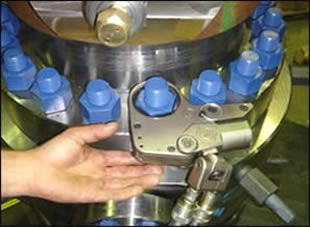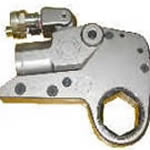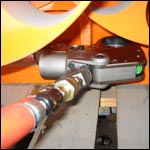|
WHAT IS TORQUE?
Today's torque wrenches are available in many types, shapes and sizes. They measure in Inch Pounds, Foot pounds, Newton Meters etc. Powered torque tools provide a rotating force while offering a reading or measurement of the rotation being applied. One example of torque measurement are motors where their final output is rated in Newton Meters Torque. This provides the consumer with a value or rating to assess if the motor suits their requirements. The other common application is the tightening of fasteners eg: bolts, nuts and threaded joints.
Torque measurement is used to ensure a set value or known rotating force is applied. It simply ensures the fastener is not too lose or tight. When we tighten a bolt we are stretching the thread like a spring. All bolts need to be within their "elastic range" or elongation. If over stretched, the material in the thread will be compromised. Like over stretching a spring it will loose its elasticity and not spring back. Once this has occurred the bolt will break or fail. All bolts or studs have an elastic range that can not be exceed.
If fasteners are under stretched or tensioned, the fastener will loosen. This occurs because the friction or load is not great enough to retain threaded grip. Torque measured in Foot Pounds means if were to place a one pound weigh at the end of a one foot ruler, we would produce one Foot pound, of rotating force at the opposite end of the ruler.
In Australia from around 1985 Mining Power Generation & Petrochemical Industries have expanded and advanced considerably. Australian resources like Coal, Gold, Copper, Uranium, Iron Ore, have been in demand. This has resulted in the need for bigger and better processing plants to meet demand. Bigger processing plants means more maintenance. Maintenance for processing companies means downtime. Downtime simply means no profit and costs.
Less maintenance means more production and better profits. That's why torque tools are now used to assemble bolted components. They simply improve reliability of bolted components & reduce downtime.
PLANT RELIABILITY
Industry now runs 24/7 and reliability is critical. Gone are days where bolts are tightened using overhead cranes pulling on spanners or swinging sledge hammers. Surprisingly these methods where common place well into the mid 90s. This meant applying correct bolt load was all guess work! Companies were looking for better ways to ensure even and measured torque could be applied. Achieving this meant companies could improve reliability of bolted components resulting in decreased downtime and improved profits.
In the past 30 years, torque tools have evolved and improved in many ways. Factors such as their physical size, weight , speed, torque accuracy & reliability. Power to Weight has been improved through better design and advancements in stronger and lighter materials.
SAFETY
Safety has also played a major role in the need to use a torque wrenches. Not so long ago workers put themselves in dangerous situations when trying to tighten large bolting. Loosening of bolting also creates many challenges for trades people. Corrosion, heat dust, all effect fasteners after many years of assembly. Its estimated a bolt at 100 Ft Lbs may require 300 Ft Lbs to Loosen after many years. Powered Torque tools can also be used for loosening. This has provided a much safer & faster solution.
SPEED
Heavy Plant and machinery can involve thousands of bolts. Down time of plant means no production. Powered Torque tools have been a major factor in decreasing shutdown times. In the past, companies would waist many thousands of hours trying to undo old corroded bolting. Their options were using Oxy Torches, rattle guns and slogging wrenches. These methods were time consuming, not safe, and cost companies big time. Powered Torque Tools offer great solutions. Used in reverse they only take seconds to loosen tight bolts.
TYPES OF TORQUE TOOLS
Torque tools, generally speaking are in two categories. Hand & Powered. The powered can be via Hydraulic, Pneumatic, Battery or Electric. Please see the pictures and explanations below for more information.
TORQUE & TENSION
Torque or Tension? Torque involves placing a torque tool on a threaded fastener which rotates it until and pre determined torque value in achieved. Rotating the nut pulls the thread through resulting in the fastener being stretched. Tensioning involves screwing a Hydraulic Stretching Cylinder onto the thread. By pressurizing the cylinder it stretches the thread and the nut is nipped up then the pressure released.
Heater bolts is another method used. The studs are normally hollow. A gas flame or electric induction is used inside the stud to heat it. The heat expands the metal which in turn elongates the stud. Engineers calculate a required elongation in thousands of an inch, to archive a clamping force in psi. Once the required elongation is achieved, the nut is locked up before the stud cools. The stud cools and contracts creating a pressure to the bolted joint.
The aim of these methods is to achieve a measured bolt elongation using readings or measurements. Methods used depend on the requirements of the application. Different argument or opinion decide which method is best suited. Both methods have their advantages and its normally a decision for manufactures or engineers to make.
Some would argue when dealing with more critical joints with multiple bolts its more about just applying a consistent elongation to each bolt rather than torque or tension. Others might argue its the accuracy of the elongation itself. After 20 years seeing outcomes our experience is its mostly comes down the preparation of the stud, nut, jointed surface and correct application. Neither Torque or tension will be accurate without this.
Torque certainly is the more popular. It wins hands down for simplicity, cost, versatility and ease of use. Tensioning generally speaking is suited to unique applications like Turbine Casing bolts due the length and size of the studs.
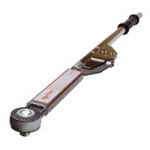 |
HAND TORQUE WRENCHES: Hand operated torque tools produce torque using the operators own force. The operator is required to push or pull on the handle. Most tools can be preset and alert the operator with a "click" when the torque is achieved. These tools can measure in Inch & Ft Lbs & in Newton Meters. Their range can be from 10 Inch Pounds up to around 1,000 Ft Lbs. These Hand tools are predominantly used by the automotive and small manufacturing industries. An accuracy of around + or - 5% is expected however variations may occur from different users. Hand Torque Tools offer great solutions for Applying torque to improve fastener reliability in light industry. |
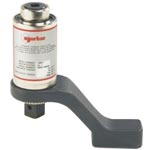 |
HAND TORQUE MULTIPLIERS: Torque Multipliers use Gearbox ratios to achieve torque multiplication. Not unlike the gearbox in your car, where the 1st gear ratio provides a torque or power advantage. Torque Multipliers offer better access, power and accuracy over impact guns and hand tools. Ratios are many, 5:1, 12:1, 15:1, etc. They work by placing a hand torque wrench in the input e.g. you apply 10Ft Lbs through a 5:1 Ratio to achieve 50 Ft Lbs output. Notes: Torque Accuracy can vary from user to user. Multipliers are generally used in light industry or in the field where there are no power. |
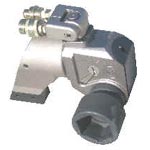 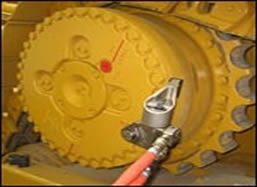 |
Hydraulic Torque Wrenches (Square Drive): These tools use a small Hydraulic ram which pushes rotates a ratchet gear. The tool is driven by a High Pressure Hydraulic pump connected by hoses. The pumps have a Variable pressure regulator from 1,500 to 10,000 psi . By adjusting the pressure you can control the torque output. A Torque chart is used showing Torque & Pressure figures for torque settings. Once set, the tool will stall or stop ratcheting when the pre set pressure is achieved. This model is for use with Impact Sockets. It has Square Drive Sizes from 1/2" up to 2-1/2" . Their are 6 tool sizes providing from 200 - 48,000 Ft Lbs ( 300 - 60,000 nm ) Hydraulic tools torque tools offer the highest output for for their size with the lightest weights. All these attributes has made them very popular. They cater from light industry right through to Heavy Industry. |
|
Hydraulic Torque Wrenches - Hex Cassette: These tools use a small Hydraulic Cylinder inside the tool which pushes onto a ratchet gear. The tool is driven by a High Pressure pump connected via flexible hoses. The pumps have a Variable pressure regulator from 1,500 to 10,000 psi . By adjusting this pressure you can control the torque output. A Torque chart is used showing Torque & Pressure figures for torque settings. Once set, the tool will stall or stop ratcheting when the pre set pressure is achieved. This model uses Hex Cassettes or Ratchet Links. These are required when overhead clearance is minimal, and a thinner tool is required. They are also ideal for long studs as the stud passes through the tool. Their are about 6 tool sizes providing from 200 - 32,000 Ft Lbs. Hydraulic torque tools have the best torque accuracy and repeatability as they have less external variables. For These tools + or - 3% or better is expected. Hydraulic tools are generally the more expensive option but there size , power to weight and torque accuracy advantages make them popular. They cater from light right through to Heavy Industry. Hydraulic Hex Link cassette tools are the solution for long studs and tight access. |
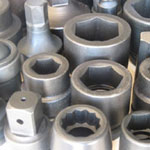 |
Impact Sockets for torque tools & Impact: Impact Sockets or Torque sockets are a heavy duty version of normal sockets. They feature a thicker wall and use higher grade materials and hardening process to improve their strength recommended for High Torque applications. |
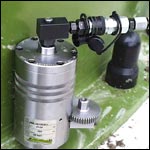 |
TENSIONERS: Tensioning involves screwing a Hydraulic Stretching Cylinder onto the thread. By pressurizing the cylinder it stretches the thread and the nut is nipped up by hand and the pressure released. There are several types. Hydraulic nuts and mechanical types are available. |

